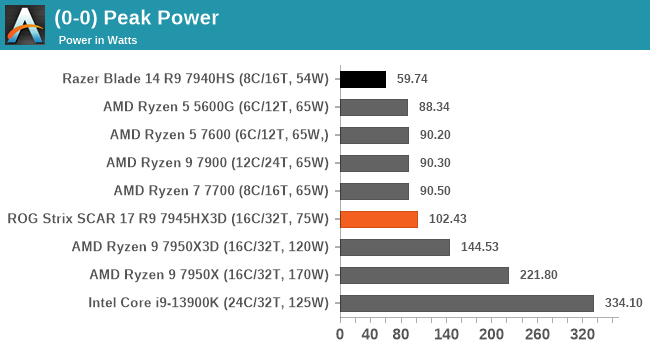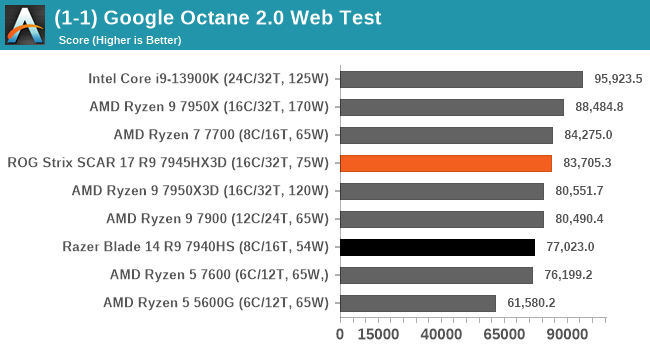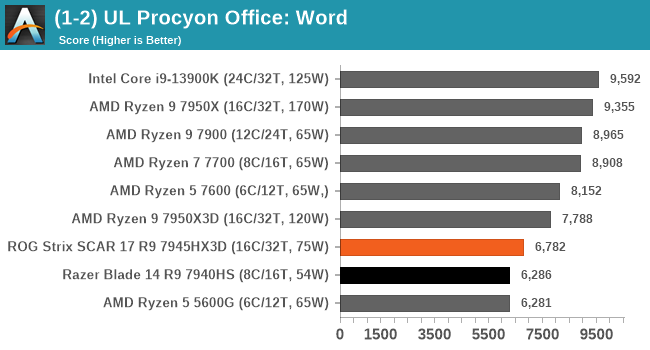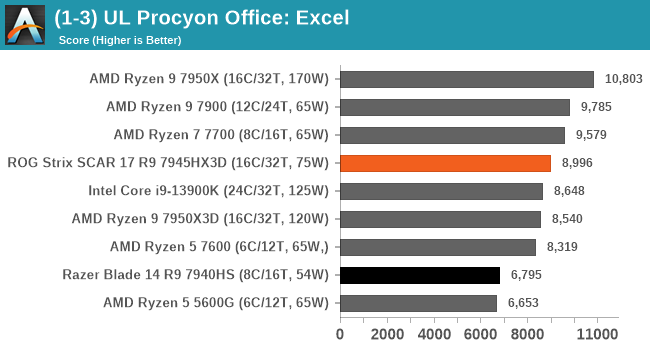The ASUS ROG Strix Scar 17 (2023) Laptop Review: Mobile Ryzen 9 7945HX3D with 3D V-Cache Impresses
by Gavin Bonshor on August 22, 2023 9:00 AM ESTROG Strix Scar 17 (2023): System & Storage Performance
As we did in our review of the Razer Blade 14 (2023) gaming notebook, we're also including desktop chips from the Ryzen 7000 series and Intel's flagship Core i9-13900K for good measure. One reason is as we refine our new notebook and laptop testing protocols, we're still building up a database of relevant data points. The other reason, and perhaps the most important, is that the AMD Ryzen 9 7945HX3D and other Ryzen 7045HX series processors are designed to be desktop replacements. This means they can/will operate with higher power draw than other mobile platforms, with the aim of delivering as close to, and in some cases, beating desktop chips in the process.
For all of the desktop chips within this comparison, as we expand our list of notebooks tested, we'll have more effective and comparable data points in the future. To add more reference, all of the desktop and mobile chips in our graphs have been tested with Windows 11 22H2.
Power

Regarding power, AMD has put a lot of focus on efficiency and the amount of performance associated with lower power envelopes on the Zen 4 architecture. Even from our review of the Razer Blade 14 (2023) with AMD's truly mobile Ryzen 9 7940HS, performance is delivered even at a measly 60 W. In our desktop reviews of AMD's Ryzen 7000 series processors, we already know that AMD's Zen 4 core performs at lower wattages, which, when it comes to a mobile platform, is important.
In the case of the Ryzen 9 7945HX3D, more power is drawn because it is simply a desktop replacement chip for a mobile chassis and, as such, has a TDP that ASUS seems to have tuned for around 75 Watts. In our power testing, the Ryzen 9 7945HX3D drew just over 102 W from the 16C/32T chip itself, which is around 40 W less than its desktop counterpart, the Ryzen 9 7950X3D (120W TDP). Given the Ryzen 9 7945HX3D has a configurable TDP of between 55 and 75 W, notebooks such as the ROG Strix Scar 17 are fully utilizing as much of the power available designed to deliver leading-edge performance in a small and portable (albeit large) 17-inch gaming laptop.
Web & Office
The next section of our updated notebook test suite is web and office-based tests. Our updated notebook suite runs in parallel with our current CPU test suite for 2023. It allows us to blend mobile chips tested with desktop chips, mainly to see efficiency and performance levels and how they stack up for each generation we try.

Using the Chromium-based Google Octane 2.0 web test, AMD's Ryzen 9 7945HX3D performs exceptionally well, even coming in slightly ahead of the desktop Ryzen 9 7950X3D and not being too far off the Ryzen 9 7950X. It's worth noting that while sometimes Octane results within a certain parameter can be similar, eg, the Ryzen 7 7700 beat the majority of chips and is an 8C/16T, everything on this chip is on one CCD, which did seem to make a slight difference in this specific benchmark.


With the combination of Microsoft's 365 Office suite and the UL Procyon Office benchmark, we can see the Ryzen 9 7945HX3D performs well for office-based tasks, especially with a score of 8996 in Excel, which actually puts it ahead of Intel's desktop Core i9-13900K. It didn't perform as well in Word, and we re-ran this test multiple times to see if it was an anomaly, but alas, it wasn't.
Storage
Storage performance is dictated by more than just putting in the fastest drive you can; other variables include the interface used, the quality of the controller, and the overall drive. The ASUS ROG Strix Scar 17 sample we received has an unspecified 1TB PCIe 4.0 x4 M.2 SSD installed. The specific part number for the drive installed into the laptop is HFS001TEJ9X101N, which we know is SK Hynix based, and from doing some digging, it looks to be the SK Hynix PC801. As is with OEM-based storage drives that come with notebooks, these can be subject to change through the product's production life cycle.
While we weren't able to find any specifics or specifications on the SK Hynix HFS001TEJ9X101N 1 TB PCIe 4.0 x4 SSD that came installed into the ROG Strix Scar 17 gaming notebook, we can see that it's a high-performance drive. Using CrystalDiskMark 8.0.4 to evaluate performance, we saw sequential read speeds of up to 7350 MB/s, with sequential write speeds of up to 5800 MB/s. Depending on whether the data is compressed or uncompressed, there's always overlap, which means raw benchmark data can vary.
When judging and measuring storage performance, it comes down to real-world performance and ensuring optimal cooling, especially on these fast NVMe drives, which can run very hot and thermally throttle, reducing performance.



Comparing the storage within the ASUS ROG Strix Scar 17 (SK Hynix PC801) to the Razer Blade 14 (Samsung PM9A1), we can see that the SK Hynix within the Scar 17 performs noticeably better in PCMark 10's integrated storage benchmark. Typically, there can be variance with SSDs, especially with different densities, controllers, and other variables that need to be considered. Overall the storage performance of the ROG Strix Scar 17 is really good and is expected from a gaming laptop with a PCIe 4.0 x4 interface.











23 Comments
View All Comments
meacupla - Tuesday, August 22, 2023 - link
any shots of the internals? I would hope this size of laptop supports more than 1 SSD.Ryan Smith - Tuesday, August 22, 2023 - link
Sorry, no shots of the internals. We were on a tight deadline here since Gavin had to catch a flight to Malaysia.We'll see about adding some once he's back.
meacupla - Tuesday, August 22, 2023 - link
that's understandable. I look forward to themQasar - Tuesday, August 22, 2023 - link
try the toms hardware review. it has pics of the internals. and it looks like it does support 2 m2 ssdsballsystemlord - Tuesday, August 22, 2023 - link
I also look forward to internal pictures.skaurus - Tuesday, August 22, 2023 - link
I'm curious if it's possible to overclock memory there to 6000? If i'm not wrong, then all actual memory chips are rated for less than 6000, so all 6000 modules are actually overclocked. So that should be possible to replicate? And that would the be sweet Zen 4 spot.dk40 - Tuesday, August 22, 2023 - link
Unfortunately, there are situations that this laptop can't deal with.Want good audio? It isn't on here cause it's using Realtek audio.
Want good ethernet performance? It isn't on here cause it's using a Realtek LAN.
The moment a laptop goes over $2000, they need to provide far better solutions for Ethernet and Audio as forcing somebody to pay even more money for external devices is a slap in the face.
meacupla - Tuesday, August 22, 2023 - link
wait, you don't use a sound isolating headset with your laptop?Realtek ethernet is okay. It's about as reliable as Intel ethernet these days, which is to say they are both not reliable with drivers.
The worst offender in there is the Mediatek Wifi. That thing is dogshit
shing3232 - Wednesday, August 23, 2023 - link
I got good experience with mtk 7922, it's a lot better than AX200 or 210 from intel.ballsystemlord - Tuesday, August 22, 2023 - link
Well, Intel Ethernet has had bugs for years with 2.5G, IIRC.Realtek audio isn't that bad, it's the junky implementations that make it sound really bad from what I've read over the years.